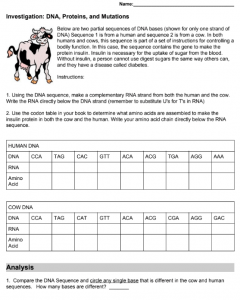
Students explore how DNA becomes a function protein by using a codon chart to transcribe and translate a gene. They compare the gene found in humans to that found in other animals, deducing that the genes are very similar with only slight changes.
Finally, students examine the different types of mutations and how a change in the DNA can result in a change in the function of the protein. This activity reinforces the concepts of transcription, translation and protein folding.
They compare how point mutations and frameshift mutations have very different overall impacts on the final amino acid sequence. They are also exposed to the concept of a nonsense mutation where a stop codon can cut an amino acid chain short.
They also explore the concept of redundancy in the code, where some changes in DNA result in no change in the final protein (silent mutations.)
Grade Level: 9-12
Time Required: 30-45 minutes
HS-LS1-1 Construct an explanation based on evidence for how the structure of DNA determines the structure of proteins which carry out the essential functions of life through systems of specialized cells.

